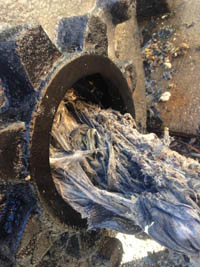What we flush impacts the environment
When we flush the wrong things down the toilet or drain, it creates problems for pipes and pumps in the wastewater system and can harm the environment.
These items should NOT go down the toilet or drain:
- Wipes (even if they are labeled "flushable," they do not break down)
- Tissues and paper towels
- Dental floss
- Tampons and sanitary pads
- Condoms
- Cotton swabs and cotton balls
- Medicines
- Rags
- Fats, oils, and grease
- Clumping cat litter
Bottom line: If it isn’t toilet paper or doesn’t come out of your body, throw it in the trash.
"Flushable" wipes

Tossing so-called “flushable” wipes, paper towels, tissues, tampons, and other dense paper materials into the toilet could end up costing you quite a bundle.
These items do not break down easily or quickly, even if labeled "flushable" or "biodegradable." Wipes and tampons can get stuck in the narrow sanitary sewer service pipe that connects homes and businesses to the city’s wastewater collection system.
And if you pour grease or other congealing products down the kitchen sink, these attach to the wipes, causing “fatbergs” to form.
The result can be clogged pipes, sewage back-ups into homes, and potentially expensive repairs.
Pharmaceuticals and personal care products (PPCPs)
When we take medications (pharmaceuticals) or use personal care products like shampoos, deodorants, and cosmetics, some of those products get flushed or washed down our drains and enter the wastewater collection and treatment system. Only about half of all prescription drugs are removed by wastewater treatment.
Ecological disruption can occur at levels far below what is traditionally considered toxic, especially because pharmaceuticals are intentionally designed to enact some biological change (this is how they help the people who take them). Some observed examples of ecological disruption include hormone changes in fish and behavioral changes such as reduced predator-avoidance capabilities, reduced feeding, and lower reproduction rates.
Examples of chemicals from PCPPs found in water include:
- DEET (a key ingredient in insect repellent),
- antibiotics used to treat infections in humans and animals or used in antibacterial soaps,
- antidepressants,
- antifungals,
- hormones, and
- diabetes, cholesterol, blood pressure medications.
Household hazardous waste
Household hazardous wastes should never be flushed or poured down your home drain or a storm drain. These include unwanted paints, solvents, automotive chemicals, used motor oil, weed killers, and insect or rodent bait and killers. Proper disposal of these items helps to keep our area rivers clean and safe.
Microplastics
Tiny pieces of plastic (<5mm) referred to as “microplastics” are being found throughout the environment and are a source of concern. Fish and other wildlife often mistake microplastics for food. These microplastics are even being found in our drinking water, including bottled water. Modern wastewater treatment does a good job removing most (~97%) microplastics; however, this means that some microplastics are still entering our area rivers. Plastic fibers are the most common and troublesome form of microplastic; thousands of these microfibers can be shed each time clothing items made from synthetic materials are washed
What can you do?
- Visit the Minnesota Pollution Control Agency website for more information on how to properly dispose of unwanted over the counter and prescription medications.
- Check with your county and the state of Minnesota to learn where you can properly dispose of unwanted household hazardous waste.
- Avoid single-use plastics, such as bottled water, utensils, and shopping bags.
- Make sure whatever plastics you do use are recycled or put in the trash.
- Consider wearing more clothing made from natural fibers.
More information